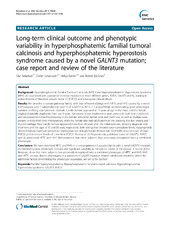| dc.contributor.author | Rafaelsen, Silje Hjorth | en_US |
| dc.contributor.author | Johansson, Stefan | en_US |
| dc.contributor.author | Ræder, Helge | en_US |
| dc.contributor.author | Bjerknes, Robert | en_US |
| dc.date.accessioned | 2014-10-01T11:33:03Z | |
| dc.date.available | 2014-10-01T11:33:03Z | |
| dc.date.issued | 2014-09-24 | eng |
| dc.identifier.issn | 1471-2156 | |
| dc.identifier.uri | https://hdl.handle.net/1956/8579 | |
| dc.description.abstract | Background: Hyperphosphatemic Familial Tumoral Calcinosis (HFTC) and Hyperphosphatemic Hyperostosis Syndrome (HHS) are associated with autosomal recessive mutations in three different genes, FGF23, GALNT3 and KL, leading to reduced levels of fibroblast growth factor 23 (FGF23) and subsequent clinical effects. Results: We describe a consanguineous family with two affected siblings with HFTC and HHS caused by a novel homozygous G-to T substitution in exon 3 of GALNT3 (c.767 G > T; p.Gly256Val), demonstrating great phenotypic variation and long asymptomatic intervals. Calcific tumors appeared at 14 years of age in the male, and the female displayed episodic diaphysitis from age 9 years. Symptoms of eye involvement were present in both from childhood, and progressed into band keratopathy in the female. Abnormal dental roots and tooth loss, as well as myalgia were present in both from their mid-twenties, while the female also had calcifications in the placenta, the iliac vessels and thyroid cartilage. New calcific tumors appeared more than 20 years after the initial episodes, delaying diagnosis and treatment until the ages of 37 and 50 years, respectively. Both siblings had elevated serum phosphate levels, inappropriately elevated tubular maximum phosphate reabsorption per unit glomerular filtration rate (TmP/GFR), reduced levels of intact FGF23 and increased levels of c-terminal FGF23. Review of all 54 previously published cases of GALNT3, FGF23, and KL associated HFTC and HHS demonstrated that more subjects than previously recognized have a combined phenotype. Conclusion: We have described HFTC and HHS in a consanguineous Caucasian family with a novel GALNT3 mutation, demonstrating new phenotypic features and significant variability in the natural course of the disease. A review of the literature, show that more subjects than previously recognized have a combined phenotype of HFTC and HHS. HHS and HFTC are two distinct phenotypes in a spectrum of GALNT3 mutation related calcification disorders, where the additional factors determining the phenotypic expression, are yet to be clarified. | en_US |
| dc.language.iso | eng | eng |
| dc.publisher | BioMed Central | eng |
| dc.relation.ispartof | <a href="http://hdl.handle.net/1956/17202" target="blank">Hereditary phosphate balance disorders in Norwegian children</a> | |
| dc.rights | Attribution CC BY | eng |
| dc.rights.uri | http://creativecommons.org/licenses/by/4.0 | eng |
| dc.subject | Familial hyperphosphatemia | eng |
| dc.subject | Hyperphosphatemic familial tumoral calcinosis | eng |
| dc.subject | Hyperphosphatemia hyperostosis syndrome | eng |
| dc.subject | GALNT3 | eng |
| dc.subject | FGF23 | eng |
| dc.title | Long-term clinical outcome and phenotypic variability in hyperphosphatemic familial tumoral calcinosis and hyperphosphatemic hyperostosis syndrome caused by a novel GALNT3 mutation; case report and review of the literature | en_US |
| dc.type | Peer reviewed | |
| dc.type | Journal article | |
| dc.date.updated | 2014-09-30T19:34:17Z | |
| dc.description.version | publishedVersion | en_US |
| dc.rights.holder | Copyright 2014 Rafaelsen et al.; licensee BioMed Central Ltd. | |
| dc.rights.holder | Silje Rafaelsen et al.; licensee BioMed Central Ltd. | |
| dc.source.articlenumber | 98 | |
| dc.identifier.doi | https://doi.org/10.1186/s12863-014-0098-3 | |
| dc.identifier.cristin | 1215015 | |
| dc.source.journal | BMC Genetics | |
| dc.source.40 | 15 | |

